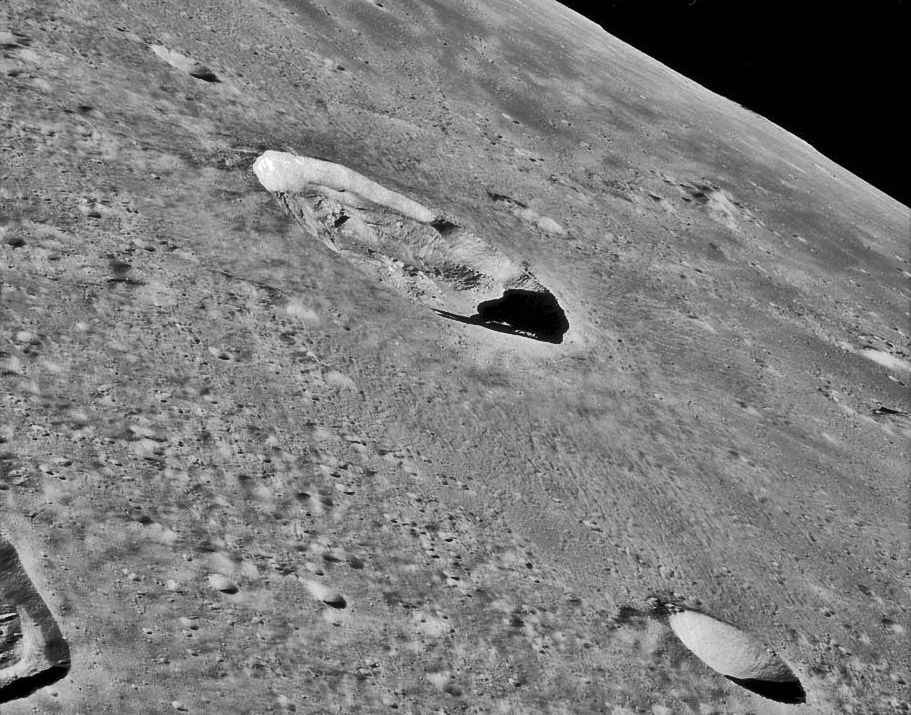|
|
| (7 intermediate revisions by the same user not shown) |
| Line 1: |
Line 1: |
| | __NOTOC__ | | __NOTOC__ |
| | =Kepler Ahead= | | =Kepler Ahead= |
| | + | <!-- Start of content --> |
| | + | <div class="post" id="post-87"> |
| | | | |
| − |
| + | <div class="storycontent"> |
| − | <div class="post" id="post-87">
| + | <p>[[File:Kepler-AS12-52-7745.jpg|Kepler - Apollo 12]]<br /> |
| − |
| |
| − | <div class="storycontent">
| |
| − | <p>[[File:Kepler-AS12-52-7745.jpg|Kepler - Apollo 12]]<br />
| |
| | <em>image by Apollo 12 crew (AS12-52-7745)</em></p> | | <em>image by Apollo 12 crew (AS12-52-7745)</em></p> |
| | <p>Some of the most dramatic lunar images ever made were shot by astronauts in orbit around the Moon. As trained observers, astronauts imaged what was scientifically interesting, and their photos often turned out to be beautiful, like this one. I have enhanced this low oblique view of Kepler to highlight the faint radial deposits in the foreground and the contrast between rays and mare in the background. With a diameter of 32 km Kepler is a small complex crater with amorphous wall slumps rather than discrete terraces. Just to the right of the central peak a small bit of flat floor – impact melt? – is visible, most of the rest of the floor is buried by the slumps. The depth of Kepler is 2.6 km, but its rim rises only about 850 m above the surroundings – craters have quite low relief compared to their diameters. One way that Kepler is extreme is the slope of its inner wall – telescopic estimates suggest it is ~42 degrees; many fresh crater walls are too steep for vehicles to traverse. </p> | | <p>Some of the most dramatic lunar images ever made were shot by astronauts in orbit around the Moon. As trained observers, astronauts imaged what was scientifically interesting, and their photos often turned out to be beautiful, like this one. I have enhanced this low oblique view of Kepler to highlight the faint radial deposits in the foreground and the contrast between rays and mare in the background. With a diameter of 32 km Kepler is a small complex crater with amorphous wall slumps rather than discrete terraces. Just to the right of the central peak a small bit of flat floor – impact melt? – is visible, most of the rest of the floor is buried by the slumps. The depth of Kepler is 2.6 km, but its rim rises only about 850 m above the surroundings – craters have quite low relief compared to their diameters. One way that Kepler is extreme is the slope of its inner wall – telescopic estimates suggest it is ~42 degrees; many fresh crater walls are too steep for vehicles to traverse. </p> |
| Line 14: |
Line 13: |
| | <strong>Related Links:</strong><br /> | | <strong>Related Links:</strong><br /> |
| | Rükl chart 30<br /> | | Rükl chart 30<br /> |
| − | [ http://www.lpod.org/archive/archive/2004/04/LPOD-2004-04-30.htm Lunar Orbiter III view]<br /> | + | [[April_30,_2004| Lunar Orbiter III view]]<br /> |
| − | [ http://www.lpod.org/archive/LPOD-2005-05-01.htm Spaceship Wes view]</p> | + | [[May_1,_2005| Spaceship Wes view]]</p> |
| − | <p align="center"><b>SUPPORT LPOD - VISIT A SPONSOR (CLICK ADS BELOW)!</b></p> | + | <p><b>Yesterday's LPOD:</b> [[February 17, 2006|Wall Stories]] </p> |
| − | </div>
| + | <p><b>Tomorrow's LPOD:</b> [[February 19, 2006|Moon Phase Maps]] </p> |
| − |
| + | <!-- Remove click bait --> |
| − | | + | </div> |
| − | ---- | + | <!-- End of content --> |
| − | ===COMMENTS?===
| + | {{wiki/ArticleFooter}} |
| − | Click on this icon [[image:PostIcon.jpg]] at the upper right to post a comment.
| |




